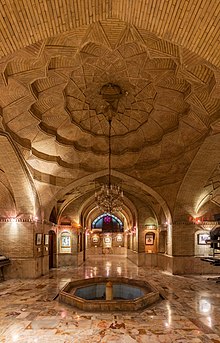| UNESCO World Heritage Site | |
|---|---|
 Edifice of the Sun (Shams ol Emareh) | |
| Location | Tehran, Iran |
| Criteria | Cultural: ii, iii, iv |
| Reference | 1422 |
| Inscription | 2013 (37th session) |
| Area | 5.3 ha |
| Buffer zone | 26.2 ha |
| Coordinates | 35°40′47″N 51°25′13″E |
The Golestan Palace (Persian: کاخ گلستان, Kākh-e Golestān) is the former royal Qajar complex in Iran's capital city, Tehran.
One of the oldest historic monuments in the city of Tehran, and of world heritage status,[1] the Golestan Palace belongs to a group of royal buildings that were once enclosed within the mud-thatched walls of Tehran's arg ("citadel"). It consists of gardens, royal buildings, and collections of Iranian crafts and European presents from the 18th and 19th centuries.[1]
Contents
1History
2Sites
2.1Marble Throne (Takht e Marmar)
2.2Karim Khani Nook (Khalvat e Karim Khani)
2.3Pond House (Howz Khaneh)
2.4Brilliant Hall (Talar e Brelian)
2.5Containers Hall (Talar e Zoruf)
2.6Ivory Hall (Talar e Adj)
2.7Mirror Hall (Talar e Aineh)
2.8Salam Hall (Talar e Salam)
2.9Diamond Hall (Talar e Almas)
2.10Building of Windcatchers (Emarat e Badgir)
2.11Edifice of the Sun (Shams ol Emareh)
2.12Museum of Gifts
2.13Abyaz Palace
2.14Museum Hall
2.15Photographic archive
3Present use
4See also
5References
6External links

The Pond House, painted by Kamal ol Molk.






沒有留言:
張貼留言